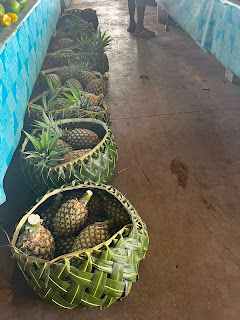DRAVUNI, FIJI
This small (2 miles long and even narrower) island has a population of around 135 to 150 inhabitants. I was told that they only allow a few ships a year to bring guests onto the island and the ship pays a fee of $5,000 to do so.
My favorite
island. The children were let out
of school for our visit. They would
often break out in song (unprompted)
The school is for lower grades only.
After that, the children go by boat to another island for classes.
Everyone was
extremely friendly and polite. There
are no stores of any kind on the island.
Just the school and family homes.
All buildings have metal roofs and a large water collection barrel. I am presuming this is their only source of
fresh water on this tiny island.
Everyone has a large garden.
The seas were very rough as we boarded the tenders. There were two staff members on the ship and another two on the tender to help each person transfer to the tender. They would tell me when to step onto the tender which would drop several feet and come back up again. Bob decided he would stay on ship but I am so glad I went to the island.























































